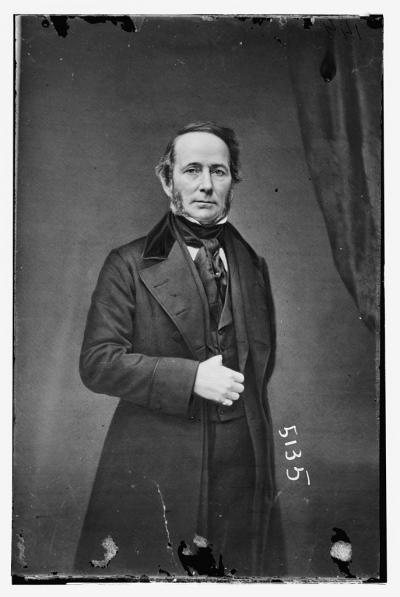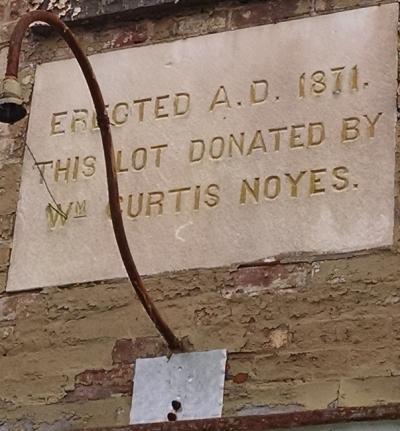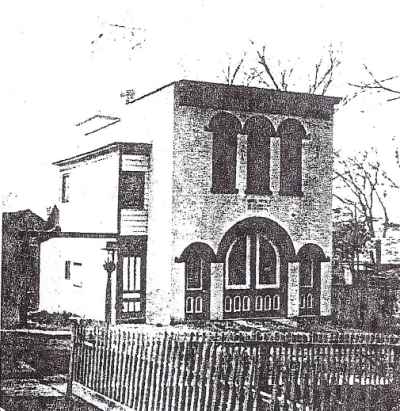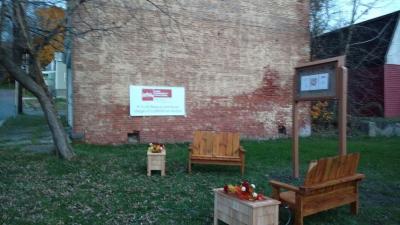In 1871, after a severe fire in the Village, a fire company organized and built this small brick engine house in Romanesque Revival style on land donated to the Village by William Curtis Noyes (1805-1864) for educational purposes. The Frank P. Harder Engine Company was organized in 1871 and was composed of 60 men for the engine company and 20 men for the hose company. A steam engine was secured which was in use for over 30 years. In 1897 it became Citizens Hose Company No. 1. According to “A Village Walk” (1977), “Tour takers can note the jail cell at the back of the building, plus its bunk for vagrants.” The jail cell is still extant on the first floor.
The building, located on lower Green Avenue, between First Street and South Main Street, is owned by the Village of Castleton-on-Hudson. The Engine House is 797.84 square feet per floor, so as a two-story building, it is 1595.67 total. It has a tin ceiling on the first floor, and a wooden one on the second. There is an enclosed exterior staircase to the second floor, and the back portion of this floor, possibly an addition, is wood frame.
The Village has acquired 2 Green Avenue, a vacant lot next to the Engine House, from Rensselaer County and in 2018, was awarded an AARP Community Challenge grant to purchase and install a community bulletin board, planters and benches at the location.
The Preservation League of New York State awarded a 2019 Preserve New York (PNY) grant to the Village. Landmark Consulting of Albany completed a building condition report in 2020 of the former engine building. By recording and documenting the exact condition of the structure, the Village will be able to prioritize repairs and create the ultimate multipurpose space in the center of downtown. The current plan is to get the property on the State Register and submit a grant application to the NYS CFA.
The Village has established a Tree Board and is pursuing Tree City designation from the Arbor Day Foundation (achieved in 2020). Trees have been planted on the 2 Green Avenue lot near the Engine House.
“William Curtis Noyes died at his residence, in this city, yesterday morning, of apoplexy. Mr. Noyes was born in Schodack, Rensselaer County, N.Y., Aug. 19, 1805. He commenced the study of law when fourteen years of age, in the office of Samuel B. Ludlow, Esq., then of Albany. In 1823 he became a student in the office of the late Hon. Henry Storrs, and in 1827, completed his studies, and was admitted to the bar. He commenced his professional life in Rome, where he was connected in business, first with the late Wheeler Barnes, Esq., and subsequently with Hon. Henry A. Foster. In 1834 he removed to Utica, and formed a partnership with William Tracy, Esq. Since 1838 he has been actively engaged in the practice of law in this city. The commanding position Mr. Noyes has for many years held at the bar in this State, his high social position and his unsullied character, and his indomitable perseverance in the prosecution of the business of his profession, will make his loss deeply felt by this community” (26 December, 1864, The New York Times).

A letter from Supreme Court Chief Justice Chase is in the January 1, 1865 edition of The New York Times. It reads: “My grief for the loss of our great and good friend is increased by the circumstances you mention. He was ever generous. I know not in what way I can manifest my sympathy with the bar of New-York in their sorrow for the removal of one of its greatest lights, but I shall be glad to do so in any appropriate manner.” According to James William Hurst (1950), “Choate singled out Sydney Bartlett and Charles G. Loring of the Boston bar, and William Curtis Noyes of New York, as among the first of the modern business lawyers” (The Growth of American Law: The Lawmakers, p. 303).
“William Curtis Noyes, LL.D., died in the city of New York, December 25th, 1864. He bequeathed his Law Library, consisting of over five thousand volumes, to Hamilton College, of which he was an honorary alumnus” (Fisher, 1866, “William Curtis Noyes: A Baccalaureate Discourse”).



